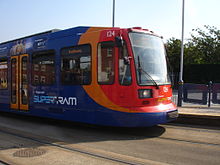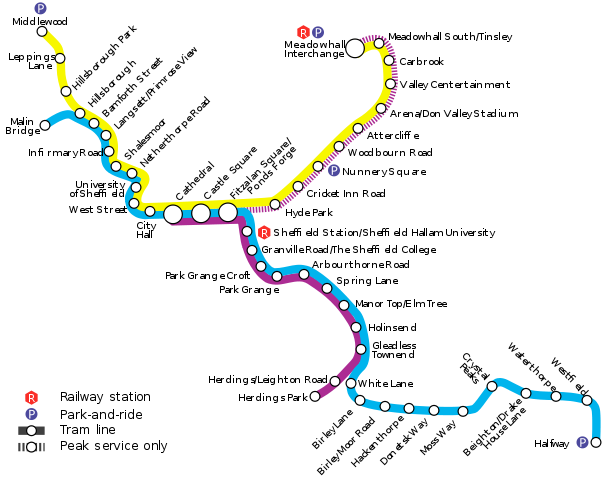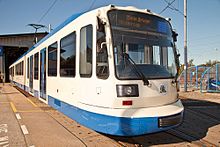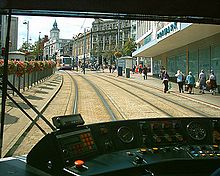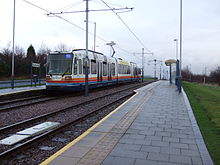- Supertram (Sheffield)
-
Supertram 

Info Locale Sheffield Transit type Electrified tramway, light rail tramway Number of lines 3 Number of stations 48 Daily ridership 36,000 (2005/6)[1] – 13.15 million/year Operation Began operation 21 March 1994 Operator(s) Stagecoach Sheffield Technical Track gauge 1,435 mm (4 ft 8 1⁄2 in)
(standard gauge)The Supertram, officially called the Stagecoach Supertram, is a light rail tram system in the City of Sheffield, South Yorkshire, England. It is owned by the South Yorkshire Passenger Transport Executive (SYPTE), who own the infrastructure, and Stagecoach who operate and maintain the vehicles.
Following a parliamentary act in 1985 authorising the scheme, the system was built by SYPTE at a cost of £240 million,[2] and opened in stages between 1994 and 1995. It was initially operated by South Yorkshire Supertram Ltd (SYSL), a wholly owned subsidiary company of SYPTE. After lower than expected passenger revenue, SYSL was sold to Stagecoach for £1.15 million at the end of 1997. With the sale of SYSL, Stagecoach gained the concession to maintain and operate the Supertram trams until 2024.[3]
Launched in an initial light grey livery, following the takeover by Stagecoach the trams wore the Stagecoach corporate livery from 1997. From 2006 the trams were refurbished, and a new dedicated Supertram blue based livery was launched, rolled out by 2008.
Ticketing is integrated with the Stagecoach Sheffield bus operations, purchased by Stagecoach in 2005.
Contents
Description
It runs from Sheffield city centre northwest to Middlewood and Malin Bridge, via the University of Sheffield and Hillsborough; northeast to Meadowhall, via Attercliffe; and southeast to Halfway and Herdings Park, via Norfolk Park, Manor, and Gleadless. Construction started in 1991 and the first section to open was along former heavy rail alignment to Meadowhall on 21 March 1994,[3] shortly after the similar Metrolink scheme in Manchester.
The system consists of a mix of on-street running, reserved right-of-way and former railway alignment. The Middlewood line runs mainly on the street up to the City Centre; the Meadowhall line runs totally on reserved track – from Attercliffe to Meadowhall it runs on former railway line alongside a freight line to Tinsley Yard and the main line at Rotherham Central. The inner part of the Halfway and Herdings Park lines consist of on-street running, with the exception of the viaduct at Granville Road. The Herdings line then runs on reserved track, and the Halfway line crosses into Derbyshire and out again on reserved lines in the countryside. This line also serves Crystal Peaks Shopping Centre.
The three main City Centre stops are located on one side of a former dual carriageway, now a single lane and reserved for buses only. These three stops are served by all routes
Network
The Stagecoach Supertram network is organised around Park Square and comprises three lines. The lines, with termini at Meadowhall, Halfway and Hillsborough, all serve Sheffield city centre and meet at Park Square where a triangular junction was constructed to provide interchange between lines and operational flexibility. Two small branches serving Malin Bridge, from Hillsborough Interchange, and Herdings Park branch out from two of the main lines.
SupertramLink
Two special Stagecoach Sheffield bus services connect with the tram, providing additional journey opportunities:
- The SL1 runs from Stocksbridge to Middlewood, the north-western terminus of the yellow route
- The SL2 is a new service which will run from Stannington to Malin Bridge, the northern terminus of the blue route
Tram stop list
Yellow Line Blue Line Purple Line - Middlewood
- Leppings Lane
- Hillsborough Park
- Hillsborough Interchange

- Bamforth Street
- Langsett/Primrose View
- Infirmary Road
- Shalesmoor
- Netherthorpe Road
- University of Sheffield
- West Street
- City Hall
- Cathedral
- Castle Square
- Fitzalan Square / Ponds Forge
- Hyde Park
- Cricket Inn Road
- Nunnery Square
- Woodbourn Road
- Attercliffe
- Arena / Don Valley Stadium
- Valley Centertainment
- Carbrook
- Meadowhall South / Tinsley
- Meadowhall Interchange


- Malin Bridge
- Hillsborough Interchange

- Bamforth Street
- Langsett/Primrose View
- Infirmary Road
- Shalesmoor
- Netherthorpe Road
- University of Sheffield
- West Street
- City Hall
- Cathedral
- Castle Square
- Fitzalan Square / Ponds Forge
- Sheffield Station / Sheffield Hallam University

- Granville Road / The Sheffield College
- Park Grange Croft
- Park Grange
- Arbourthorne Road
- Spring Lane
- Manor Top / Elm Tree
- Hollinsend
- Gleadless Townend
- White Lane
- Birley Lane
- Birley Moor Road
- Hackenthorpe
- Donetsk Way
- Moss Way
- Crystal Peaks
- Beighton / Drake House Lane
- Waterthorpe
- Westfield
- Halfway
- Meadowhall Interchange


- Meadowhall South / Tinsley
- Carbrook
- Valley Centertainment
- Arena / Don Valley Stadium
- Attercliffe
- Woodbourn Road
- Nunnery Square
- Cricket Inn Road
- Hyde Park
- Fitzalan Square / Ponds Forge
- Castle Square
- Cathedral
- Castle Square
- Fitzalan Square / Ponds Forge
- Sheffield Station / Sheffield Hallam University

- Granville Road / The Sheffield College
- Park Grange Croft
- Park Grange
- Arbourthorne Road
- Spring Lane
- Manor Top / Elm Tree
- Hollinsend
- Gleadless Townend
- Herdings / Leighton Road
- Herdings Park
Technical data
The fleet
Main article: Siemens-Duewag SupertramThe Supertram network operates a fleet of 25 three car trams built by Siemens-Duewag of Düsseldorf, Germany in 1992. The trams are capable of carrying 88 seated and 155 standing passengers and are 40% low floor design, the vehicles have been specially designed for gradients as steep as 10%. In the 1980s a design choice was taken to create the longest possible vehicle while avoiding multiple working[4] which resulted in a 34.8m design the 3rd longest tram design in operation in Europe at the time[5] and the longest in service in the UK until the 42.8m long Edinburgh Trams are introduced on the Edinburgh Network.
The track
The network is 18 miles (29 km) long, with 37 miles (60 km) of track.[6] It features two types of track; tramway track where either pedestrians or road traffic share the right of way and ballasted railway track when there are no such requirements. Tramway track consists of a grooved tramway rail set into a concrete base with troughs into which the rails are laid. Most of the track is on-street using 35G-section grooved tram rail, with BS11-80A 80 lb/yd flat-bottom rail elsewhere.[6] The railway track was supplied by British Steel Track Products of Workington and laid on sleepers consisting of concrete blocks with steel ties which gives a spring feeling when travelling on these sections. The track is laid on a bed of ballast which in turn rests on a prepared formation. Street crossings are usually laid with grooved tramway rails.
The overhead wiring
Supertram is powered through 12 electric substations and fed through 1.07 cm diameter overhead line equipment (OHLE) wire.[6] The substations convert the 11 kV AC supply into 750 V DC supply into the overhead. The 12 substations are situated as follows:
- Blackburn Meadows
- Carbrook
- Nunnery Square
- Park Square
- Arbourthorne
- Gleadless Townend
- Birley
- Crystal Peaks, Ochre Dyke Lane
- Halfway, Eckington Way
- University, Brook Hill
- Langsett Road, Capel Street
- Middlewood
The overhead line equipment depends on the location. If the tracks are close together, central poles with 'steady' arms on each side are used. If the tracks are further apart, poles on either side with span wire are used. With aesthetics in mind a minimum number of traction poles are used and whenever possible the wire is anchored onto neighbouring buildings. Supertram, Sheffield City Council and landlords were in talks to try and hide anchor points as much as possible and blend them into the structures.
The contact wires are twin cadmium copper ones, twin wires being necessary because of the high installed power rating of the trams (1 megawatt). The regenerative braking on the tram feeds current back into the wires.
Operation
The rules of operation of the Stagecoach Supertram are similar to those of a traditional railway. The system was operated by South Yorkshire Supertram Operating Company, who employed the staff and operated the depot and signalling and now by Stagecoach Supertram. Unlike normal trains, tramways can be operated without signalling, although block signalling is sometimes necessary on single-line sections. The trams are driven on a line-of-sight basis, so that the tram can be stopped if an obstruction is spotted ahead.
Signals, however, are used to give indications to tram drivers when running on-street and at street crossings. As trams have priority at many places, it was necessary to give them different traffic light phases from motor traffic and therefore different types of indication have to be used from those applicable to motor vehicles. Signal phases for the tramway are specifically modified to account for the length of the tram. The tram signals are usually operated alongside and in conjunction with traffic signals. Signals consist of white lights arranged vertically (for go), horizontally (for stop) and a cross (for caution). Two other light arrangement indicate a point direction at junctions. The five white lights are distinct from those of the standard road traffic lights or railway line-side signals.
Tramway signalsJunction signals
-

Points set for left.
-

Points set for right.
-

Points misaligned or not detected.
Points indicators are provided at junctions to indicate the route which is set through the points. At junctions, where Supertram and train movements can conflict with road traffic, fixed signals are provided in addition to points indicators. A points indicator may only be passed if it displays the correct route indication for the tram concerned and, where fixed signals are provided, if both points indicators and fixed signals are set for the correct route.
Line-side signals give instructions or warnings to tram drivers. To distinguish them from normal road signs, they are diamond-shaped. The most common are speed restrictions which are in miles per hour. These are particularly necessary on road-running where trams travel along with road traffic.
The route a tram is to take is computer-controlled. The route is set on a device in the tram before a journey is started, and on approach to junctions, a signal is sent from the tram to a device known as a VIS loop buried beneath the track. This automatically sets the points in the correct direction.
The depot
 Supertram 122, operating the Purple Route to Herdings Park, on the permanent way leaving Sheffield station for Sheffield College (Granville Road) on 5 July 2004
Supertram 122, operating the Purple Route to Herdings Park, on the permanent way leaving Sheffield station for Sheffield College (Granville Road) on 5 July 2004
The depot is located at Nunnery Square and occupies the former main line carriage sidings alongside the Sheffield – Lincoln railway line. It was designed and constructed by Balfour Beatty on 2.6 hectares of land and consists of a three-line workshop building, 6 stabling sidings, a turning loop, engineers sidings and sundry equipment. The main offices and reception, supervisor's offices, plant room, staff mess rooms, paint shop, first aid are on the first floor level on the South side of the building. The Southwest of the building is home to the Operations and Power Controller's office, where live control of the running of the service is monitored using SCADA, CCTV and radio contact. The depot substation is also located in the southwest corner, two 600 kVA transformer-rectifiers supply the tramway overhead and a 800 kVA transformer feeds the depot facilities.
In the workshop itself are two through-running lines (numbered 8 and 9) and line 10, a stub end. All lines have inspection pits and line 8 possesses a Hegenscheidt wheel lathe. This machine allows wheel turning whilst both sets of doors are closed. The wheelsets are turned in situ. High level access is provided on lines 9 and 10 for servicing of equipment boxes and pantographs. An automated washing machine is located on line 7. The depot is currently in the process of refurbishing the entire fleet of 25 trams.
The site's security is provided by CCTV and fence guarding and is under control of security personnel housed in the operations centre. Road access is from Woodbourn Road at the end of the depot.
The site was, before the arrival of Supertram, already dedicated to the railway industry, Nunnery engine shed filled most of the site whilst lines of the Midland Railway, Great Central Railway and London and North Eastern Railway irrigated the area and served collieries.
Tramstops
48 tram stops have been built to permit users accessing the Supertram.[7] These are generally found to be 26.5 m in length and 3 m in depth and are of a network-wide standard making them easy to understand and use. The design incorporates recommendations made by the Cranfield Institute of Technology who studied ergonomics for both able-bodied and disabled users.[8]
Tram stops are elevated at 37.5 cm with a 1:20 slope. The platform edge comprises a 60 cm wide and light coloured textured paving with strips of 40 cm wide edge warning tactile strip. Directional guidance tactile paving crosses the width of the platform to coincide with the tram door locations.
Notable structures
The Supertram network possesses a few remarkable structures. Two viaducts and one underpass are of interest: the two viaducts carry Supertram onto Park Square (a major road junction in the centre of the city), one of them being a six-span viaduct, the other the bowstring steel arch Park Square Bridge. The underpass takes the tram underneath the busy A57 roundabout outside the University of Sheffield.
Ticketing
Until the Stagecoach takeover, ticketing was done via ticket machines provided by Abberfield Technology of Australia. These blue ticket machines dispensed adult single ride tickets, senior citizen concessionary tickets, and child concessionary tickets. As well as singles, the machines sold multi-packs at a discount. Fare tables were shown on the machines with the validity of the different prices.
To travel, each ticket had to be validated in a yellow machine on the platform. The ticket defined the type of passenger and trip as tickets do now. On validation, an overprint was added, giving the tramstop code, time and date of validation and the point of validation.
As the machines did not dispense change, nearby shop-owners were often asked for change to purchase tickets from the machines. There were also problems with machine reliability. When Stagecoach took over South Yorkshire Supertram it removed the ticket machines and began selling tickets on board. This meant improved staff presence on board and tickets could be systematically checked.
Stagecoach Sheffield period tickets are valid on the trams and on Stagecoach buses, and period South Yorkshire PTE tickets covering Sheffield or the whole of South Yorkshire are valid on Supertram as well as buses and trains.
Unlike other tramway and light rail operators in the UK, Supertram accepts concessionary travel passes issued by any English local authority.[9]
Opening dates
- 21 March 1994: Fitzalan Square to Meadowhall
- 22 August 1994: Fitzalan Square to Spring Lane
- 5 December 1994: Spring Lane to Gleadless Townend
- 18 February 1995: Fitzalan Square to Cathedral
- 17 February 1995: Cathedral to Shalesmoor
- 27 March 1995: Gleadless Townend to Halfway
- 3 April 1995: Gleadless Townend to Herdings Park
- 23 October 1995: Shalesmoor to Middlewood/Malin Bridge
Future plans
Proposals were made to extend the network to Rotherham, Dore, Fulwood and Hellaby. However, a reduced scheme with extensions to Rotherham and Broomhill[10] failed to gain government funding in 2004.[11]
A new scheme has been announced to connect Supertram to Rotherham by way of electrifying an existing heavy rail line.[12]
See also
- Sheffield Tramway—the original Sheffield tramway system.
- Light Rail Transit Association
References
- ^ "Transport Statistics Bulletin" (PDF). Department for Transport. Archived from the original on 2010. http://webarchive.nationalarchives.gov.uk/+/http://www.dft.gov.uk/162259/162469/221412/221535/224237/224260/publictransportstatisticsbul.pdf. Retrieved 2010-06-19.
- ^ "Sheffield Supertram information". BBC South Yorkshire. BBC. http://www.bbc.co.uk/southyorkshire/content/articles/2005/10/06/sheffield_supertram_feature.shtml. Retrieved 2009-03-11.
- ^ a b Courtenay, Peter. "Sheffield Supertram: History". TheTrams.co.uk. http://www.thetrams.co.uk/supertram/history.php. Retrieved 2007-08-19.
- ^ http://www.supertram.com/uploads/Designingourtrams.pdf
- ^ http://www.supertram.com/uploads/vehicleinfo.pdf
- ^ a b c "About us: Technical". Stagecoach Supertram website. http://www.supertram.com/technical.html. Retrieved 2007-08-19.
- ^ Courtenay, Peter. "Sheffield Supertram: Facts and figures". http://www.thetrams.co.uk/factsnfigures.php?section=supertram. Retrieved 2007-08-19.
- ^ "About us: Access". Stagecoach Supertram website. http://www.supertram.com/access.html. Retrieved 2007-08-19.
- ^ "Stagecoach Supertram Ticket Information". Stagecoach Group. http://www.supertram.com/ticketinformation.html. Retrieved 2010-01-04.
- ^ [1][dead link]
- ^ "Bitter blow over plan for Supertram". Sheffield Star (Sheffield Newspapers Ltd). 7 July 2006. http://www.thestar.co.uk/template/ViewArticle.aspx?SectionID=58&articleid=1614642. Retrieved 2007-08-19.
- ^ [2]
External links
- Supertram website
- Stagecoach Supertram at thetrams.co.uk
- Collection of Google Earth locations of Stagecoach Supertram stops (Requires Google Earth software) from the Google Earth Community forum.
- Supertram gallery
- Supertram specs
Stagecoach Sheffield Supertram
Operations OperatorsVehiclesSiemens-Duewag Supertram (fleet numbers 101-125)DepotsNunnery Square
Stations Purple LineHerdings Park · Herdings / Leighton Road · Gleadless Townend · Hollinsend · Manor Top / Elm Tree · Spring Lane · Arbourthorne Road · Park Grange · Park Grange Croft · Granville Road / The Sheffield College · Sheffield Station / Sheffield Hallam University · Fitzalan Square / Ponds Forge · Castle Square · Cathedral · Castle Square · Fitzalan Square / Ponds Forge · Hyde Park · Cricket Inn Road · Nunnery Square · Woodbourn Road · Attercliffe · Arena / Don Valley Stadium · Valley Centertainment · Carbrook · Meadowhall South / Tinsley · Meadowhall InterchangeBlue LineHalfway · Westfield · Waterthorpe · Beighton / Drake House Lane · Crystal Peaks · Moss Way · Donetsk Way · Hackenthorpe · Birley Moor Road · Birley Lane · White Lane · Gleadless Townend · Hollinsend · Manor Top / Elm Tree · Spring Lane · Arbourthorne Road · Park Grange · Park Grange Croft · Granville Road / The Sheffield College · Sheffield Station / Sheffield Hallam University · Fitzalan Square / Ponds Forge · Castle Square · Cathedral · City Hall · West Street · University of Sheffield · Netherthorpe Road · Shalesmoor · Infirmary Road · Langsett / Primrose View · Bamforth Street · Hillsborough · Malin BridgeYellow LineMiddlewood · Leppings Lane · Hillsborough Park · Hillsborough · Bamforth Street · Langsett / Primrose View · Infirmary Road · Shalesmoor · Netherthorpe Road · University of Sheffield · West Street · City Hall · Cathedral · Castle Square · Fitzalan Square / Ponds Forge · Hyde Park · Cricket Inn Road · Nunnery Square · Woodbourn Road · Attercliffe · Arena / Don Valley Stadium · Valley Centertainment · Carbrook · Meadowhall South / Tinsley · Meadowhall InterchangeProposed ExtensionsItalics indicate stations only stopped at during peak times.UK light rail systems Tramways CurrentBlackpool tramway · Manchester Metrolink · Midland Metro · Nottingham Express Transit · Sheffield Supertram · TramlinkFutureEdinburgh TramsProposedCancelledBristol Supertram · CITI Belfast · Cross River Tram · Leeds Supertram · Merseytram · Penistone Line Tram-Train · West London Tram
Metro CurrentProposedNorth and West London Light Railway · West London OrbitalPreserved Black Country Living Museum · East Anglia Transport Museum · Heaton Park Tramway · National Tramway Museum · Seaton Tramway · Wirral Transport Museum · Wirral TramwayKey personnel United Kingdom
bus companiesStagecoach London (East London, Selkent, Thameside) · Stagecoach West Scotland (Western, A1 Service, Arran, Glasgow) · Stagecoach Highlands (Caithness, Inverness, Lochaber, Skye, Orkney) · Stagecoach East Scotland (Fife, Bluebird, Perth, Strathtay, JW Coaches, Rennies) · Stagecoach North East (Newcastle, South Shields, Sunderland, Hartlepool, Teesside) · Stagecoach North West (Cumbria, Lancaster, Lancashire, Preston, Network Chorley) · Stagecoach Manchester (Manchester, Magic Bus) · Stagecoach Merseyside (Merseyside) · Stagecoach Yorkshire (Yorkshire, Chesterfield, Sheffield) · Stagecoach East Midlands (Bassetlaw, Mansfield, Grimsby-Cleethorpes, Hull, Lincolnshire) · Stagecoach Midlands (Northants, Warwickshire) · Stagecoach Oxfordshire (Oxfordshire, Oxford Tube) · Stagecoach East (Stagecoach Cambridgeshire (Cambridge, Peterborough. The Fens), Bedford) · Stagecoach West (Cheltenham, Swindon, Gloucester, Cotswolds, Wye and Dean) · Stagecoach Wales (Stagecoach in South Wales) · Stagecoach South East (East Kent, East Sussex, Eastbourne, Hastings) · Stagecoach South (Hants & Surrey, Hampshire, Portsmouth, South Downs) · Stagecoach South West (Devon) · Stagecoach Express · Scottish Citylink (35% with ComfortDelGro) · Megabus (United Kingdom) · Stagecoach Gold/Citylink GoldUnited Kingdom
railway companiesEast Midlands Trains · South West Trains (Island Line Trains) · Virgin Trains (49% with Virgin Group) · MegatrainUnited Kingdom
tram operationsStagecoach Sheffield SupertramNorth American
bus companiesUnited States: Coach USA (Northeast: Community Coach, Gray Line New York (50% with New York Airport Service), Olympia Trails, Red & Tan Tours, Rockland Coaches, Short Line Bus, Suburban Trails) · (North Central: Butler Motor Transit, Central Cab Company, Coach USA Chicago, Lenzner Coach Lines, Tri-State/United Limo, Wisconsin Coach Lines, Van Galder) · Megabus (North America)
Canada: Coach Canada: Erie Coach Lines, Trentway-Wagar, Gray Line MontrealAnnual revenue: £2,176 million GBP ( 8.9% FY 2007) · Employees: 27,000 · Stock symbol: LSE: SGC · Website: stagecoachgroup.comCategories:
8.9% FY 2007) · Employees: 27,000 · Stock symbol: LSE: SGC · Website: stagecoachgroup.comCategories:- Stagecoach Group rail services
- Light rail in the United Kingdom
- Transport in Sheffield
- Tram transport in England
- Railway lines opened in 1994
- Electric railways in the United Kingdom
Wikimedia Foundation. 2010.


